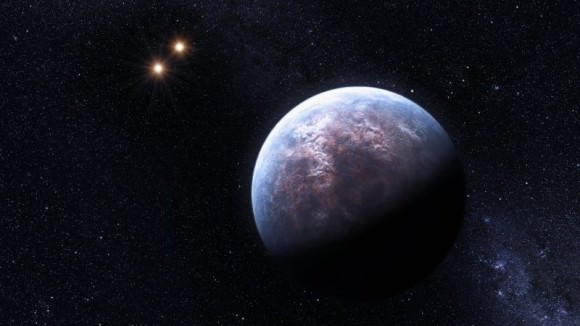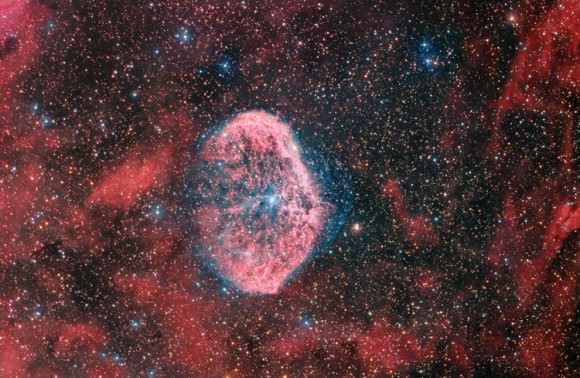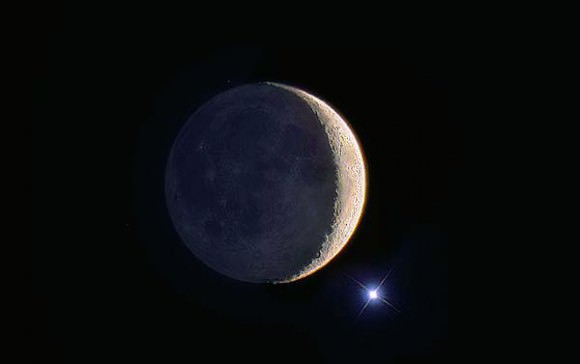The Orionid Meteor Shower – What Did You See?
If you had the opportunity this morning to witness the offspring of Comet Halley, then I'm curious as to what you might have noticed about this reliable annual meteor shower. (...)
Read the rest of The Orionid Meteor Shower – What Did You See? (303 words)
This Week's Where In The Universe Challenge

It’s time once again for another Where In The Universe Challenge. Test your visual knowledge of the cosmos by naming where in the Universe this image was taken and give yourself extra points if you can name the spacecraft responsible for this picture. Post your guesses in the comments section, and check back later at this same post to find the answer. To make this challenge fun for everyone, please don’t include links or extensive explanations with your answer. Good luck!
(...)
Read the rest of This Week's Where In The Universe Challenge (0 words)
Have a Galileo Moment

Starting tomorrow (Oct. 22) professional and amateur astronomers around the world will be out in force to encourage as many people as possible to look through a telescope. The International Year of Astronomy 2009 Cornerstone project, Galilean Nights, will be a global experience, with more than 1000 public observing events in over 70 countries. If you participated in 100 Hours of Astronomy that took place in April 2009, this event is similar, but this time astronomers will be focusing on the objects that Galileo observed, especially with the Moon and Jupiter well-positioned in the evening sky.
(...)
Read the rest of Have a Galileo Moment (136 words)
LRO, Chandrayaan-1 Scientist Arrested for Espionage

Times are tough, but you have to wonder what this guy was thinking. Stewart David Nozette, 52, who was involved in the recent discovery of water on the Moon by the Chandrayaan-1 spacecraft has been arrested for espionage for allegedly trying to sell details of US missile detection satellites in exchange for cash. Nozette was attempting to sell classified information to a person who he believed was an Israeli intelligence officer. Nozette is a fairly prominent scientist who helped conceive the 1994 Clementine mission to the Moon, and currently is a co-investigator on Chandrayaan-1, the Indian Moon mission, and on an instrument aboard the Lunar Reconnaissance Orbiter.
(...)
Read the rest of LRO, Chandrayaan-1 Scientist Arrested for Espionage (277 words)
Could a Black Hole Fit in Your Computer or In Your Pocket?

Some of the most frequently asked questions we get here at Universe Today and Astronomy Cast deal with black holes. Everyone wants to know what conditions would be like at the event horizon, or even inside a black hole. Answering those questions is difficult because so much about black holes is unknown. Black holes can't be observed directly because their immense gravity won't let light escape. But in just the past week, three different research teams have released their findings in their attempts to create black holes – or at least conditions analogous to them to advance our understanding.
(...)
Read the rest of Could a Black Hole Fit in Your Computer or In Your Pocket? (769 words)
HARPS Discovers 32 New Exoplanets
Astronomers have found 32 new planets outside our solar system with the High Accuracy Radial Velocity Planet Searcher, better known as HARPS, the spectrograph for the European Southern Observatory's (ESO) 3.6-metre telescope. The number of known exoplanets is now at 406, and HARPS itself has discovered more than 75 exoplanets in 30 different planetary systems. Included in this most recent batch are several low-mass planets – so-called "Super Earths" about the size of Neptune. The image above is an artist's impression of a planet discovered that is 6 times the mass of Earth, which circles the low-mass host star, Gliese 667 C, at a distance equal to only 1/20th of the Earth-Sun distance. Two other planets were discovered previously around this star.
"HARPS is a unique, extremely high precision instrument that is ideal for discovering alien worlds," said ESO astronomer Stéphane Udry. “We have now completed our initial five-year program, which has succeeded well beyond our expectations.”
(...)
Read the rest of HARPS Discovers 32 New Exoplanets (259 words)
Giant Impact Near India — Not Mexico — May Have Killed Dinosaurs
A huge, mysterious basin off the coast of India could be the largest, multi-ringed impact crater ever found on Earth. And if a new study is right, this impact may supercede the one that created the Chicxulub crater off Mexico's Yucatán Peninsula as what may have been responsible for killing the dinosaurs 65 million years ago. Sankar Chatterjee of Texas Tech University and a team of researchers have been studying a 500-kilometer-wide (300-mile-wide) depression on the Indian Ocean seafloor which was likely created by a bolide perhaps 40 kilometers (25 miles) in diameter. Such an event would have triggered worldwide climate changes, including intensified volcanism, that led to mass extinction.
(...)
Read the rest of Giant Impact Near India — Not Mexico — May Have Killed Dinosaurs (507 words)
Launches and Dockings and Robots, Oh My!

It was a busy weekend in the world of space flight — both present and future — and so we'll try to fit it all in one article, and include a couple of videos to help tell the stories. Before that, however, just a reminder that the Ares-I-X is slated to roll out to launchpad 39-B early Tuesday morning at 12:01 am EDT, to begin preparations for the scheduled Oct. 27 first test launch. If you're an early bird, (or a night owl) watch the six-hour trip on NASA TV.
And now on to this weekend's launch story:
(...)
Read the rest of Launches and Dockings and Robots, Oh My! (301 words)
MER Team Prepares to Extract Spirit

To prepare for an actual attempt to extract the Spirit rover from its sand-trapped predicament, engineers using test rovers on Earth have added a new challenge. Until last week, those commanding and assessing drives by the test rovers were usually in the same room as the sandbox setup simulating Spirit's predicament, where they can watch how each test goes. That changed for the latest preparation, called an operational readiness test.
(...)
Read the rest of MER Team Prepares to Extract Spirit (315 words)
NASA Science News for October 19, 2009
Caused by debris from Halley's Comet, the 2009 Orionid meteor shower peaks on Wednesday, Oct. 21st, and forecasters say it could be an unusually good show.
FULL STORY at
http://science.nasa.gov/headlines/y2009/19oct_orionids.htm?list1035898
Opportunity Discovers Still Another Meteorite! Find It on Google
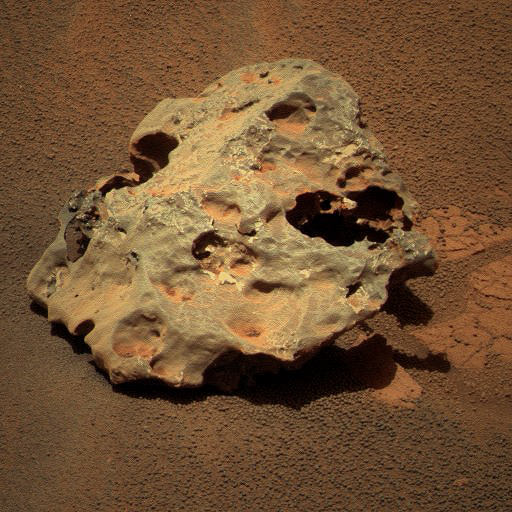
Mackinac on Mars. Credit: NASA/JPL/ colorization by Stuart Atkinson
Opportunity must be driving down Meteorite Alley on Mars. The rover has come across still another meteorite, the third space rock it has found the past few months, and fourth overall since 2005. This one is called Mackinac, which continues the "island" theme by which the science team has dubbed the meteorites. Block Island was found in July 2009, and Opportunity came upon Shelter Island the end of September (around sol 2020 for the rover). Mackinac was found on sol 2034 (Oct 13), and it looks very similar in composition to the two earlier meteorites. Opportunity analyzed the Block Island and found it was made of iron and nickel.
The image above was color calibrated by Stu Atkinson, who hangs out at UnmannedSpaceflight.com. You can find all the raw images Opportunity has sent back to Earth here, and raw images from Spirit here. But you can also follow Opportunity in other ways….
(...)
Read the rest of Opportunity Discovers Still Another Meteorite! Find It on Google Mars (281 words)
Moon Crash Plume Visible to Spacecraft But Not Earth Telescopes
Nine science instruments on board the LCROSS spacecraft captured the entire crash sequence of the Centaur impactor before the spacecraft itself impacted the surface of the moon. But from Earth, any evidence of the plume was hidden by the rim of a giant impact basin, a 3 kilometer-high (2-mile) mountain directly in the way for Earth telescopes trained on the impact site, said Dr. Peter Schultz, co-investigator for LCROSS. Additionally, the crater created by the impact was only about 28 meters across (92 feet) but Schultz said the best resolution Earth telescopes can garner is about 180 meters (200 yards) across.
(...)
Read the rest of Moon Crash Plume Visible to Spacecraft But Not Earth Telescopes (502 words)
Where Could Humans Survive in our Solar System?
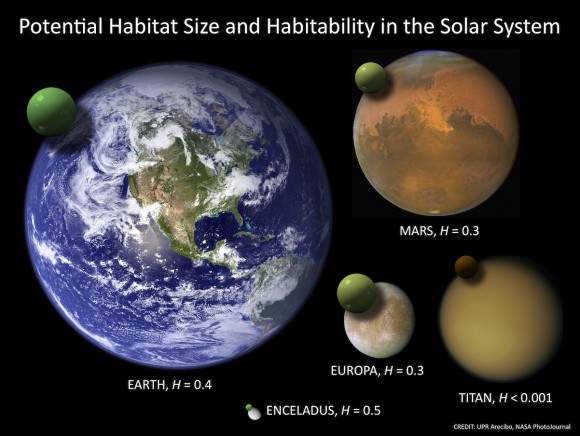
If humans were forced to vacate Earth, where is the next best place in our solar system for us to live? A study by the University of Puerto Rico at Arecibo has provided a quantitative evaluation of habitability to identify the potential habitats in our solar system. Professor Abel Mendez, who produced the study also looked at how the habitability of Earth has changed in the past, finding that some periods were even better than today.
(...)
Read the rest of Where Could Humans Survive in our Solar System? (666 words)
Hot Crescent Rolls… A Bubble?
The Crescent Nebula, also known as NGC 6888, is a very well renown and most intriguing object located in the constellation Cygnus in the northern hemisphere. At an apparent size of about 18 by 13 arc-minutes it is a very pale nebula. Even in a moderate amateur telescope you can't quite see this one unless you have absolute dark skies (or narrow band filters) and a decent "light bucket". So how do we get a chance to study it? Photographically, of course… (...)
Weekend SkyWatcher's Forecast – October 16-18, 2009
Greetings, fellow Stargazers! Were you up early this morning? If so, you were greeted by an awesome scene, much like this one captured by Danilo Pivato. There's nothing more eyecatching the a close appearance of Venus and the Moon! With dark skies this weekend, it will be a good opportunity to broaden your astronomical horizons by chasing lesser known objects in both binoculars and telescopes. Of course there are challenges, too! Whenever you're ready, I'll see you in the back yard…. (...)
Read the rest of Weekend SkyWatcher's Forecast – October 16-18, 2009 (774 words)

